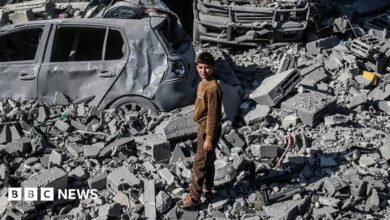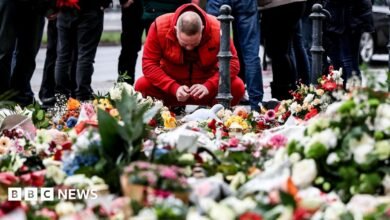Israel is deliberately targeting journalists in Gaza: Experts | Israel-Palestine conflict News

On Friday, December 15, Al Jazeera journalists Samer Abudaqa and Wael Dahdouh were reporting at the Farhana school in Khan Younis when Israel struck from the air.
Dahdouh took shrapnel to his upper arm but was able to apply pressure to the wound and escape to a nearby hospital for help.
But Abudaqa was unable to move. Rescue teams tried to reach him, but couldn’t due to Israeli bombardment. For more than five agonising hours, as he lay bleeding, campaigns were launched online and in traditional media to save his life.
“I made that call on air,” Jonathan Dagher, head of the Reporters Without Borders (RSF) Middle East Desk, told Al Jazeera from the RSF offices in Paris. “On Al Jazeera, I said: ‘We call upon the Israeli authorities to allow first aid to reach Samer.’”
Despite the repeated calls, medical aid wasn’t able to reach Abudaqa, who died of his wounds that day.
‘A pattern’… of killing journalists
Abudaqa is one of at least 130 journalists and media workers, based on RSF’s count, killed by Israel in Gaza since October 7, 2023.
Other media rights groups have different numbers based on their own criteria, while the Government Media Office in Gaza counts the number of dead journalists and media workers at 173.
This has made working as a reporter one of the deadliest professions in an already treacherous situation.
The International Federation of Journalists said the mortality rate for media workers in Gaza is over 10 percent.
Seventy-five percent of all reporters killed in the world in 2023 were killed between October 7 and the end of last year.
In December 2023, just two months into the war, the Committee to Protect Journalists said the war zone in Gaza was the “most dangerous ever” for reporters.
Nearly 11 months later, Israel is still killing journalists in Gaza.
“If there are no journalists, there’s no one who can independently verify this and tell the world,” Dagher said. “Then the Israeli army becomes the source of information.”
Some reporters in Gaza have been able to leave, but “most of them are trapped and those that were able to leave cannot come back in,” Dagher said.
“There’s a pattern,” Dagher said. “We’re 10 months in and we’re not at five or six journalists killed, which already would have been a tragedy. We are at [more than] 130 journalists killed.”
Among the more than 130 media workers and journalists who have been killed, says RSF, are 31 credible cases where there is enough information to confirm the journalists were directly targeted because of their profession.
With the death rate of reporters so high, researchers who monitor the issue told Al Jazeera that they have come to believe Israel is intentionally killing journalists and media workers, in addition to destroying Gaza’s media infrastructure.
One of these people was the co-founder of the media outlet Ain Media.
In October 2023, he communicated with Forensic Architecture, a research group investigating state violence and human rights violations, to look into the disappearances of a number of his colleagues.
Al Jazeera asked to speak with the co-founder of Ain Media, but a programme manager at Forensic Architecture replied, saying he had been “killed in an Israeli air strike several months ago at his home in a targeted attack”.
Assassination in life and death
The Israeli military has on multiple occasions killed journalists and then claimed they were armed fighters or “terrorists”. But these claims have rarely held up, according to experts and independent investigations.
On July 31, 2024, Israel killed Ismail al-Ghoul in an attack.
Al-Ghoul had been reporting for Al Jazeera for much of the war. In March 2024, he was arrested and interrogated at al-Shifa Hospital in Gaza City. Al Jazeera said the claims were baseless.
The day after Israel killed him, an Israeli military spokesperson claimed al-Ghoul was a member of Hamas’s military wing, providing since-disputed documents that al-Ghoul had been appointed to an elite unit of the group in 2007.
“In 2007, Ismail al-Ghoul was 10 years old,” said Mohammed Othman, a correspondent with the Skeyes Center for Media and Cultural Freedom from Gaza.
“There are devices that monitor faces, eye prints and facial prints, and they [the Israeli military] know who is affiliated with a military faction and who is a civilian,” Othman said.
“He was released after 12 hours [of questioning at al-Shifa Hospital]. Is it possible that he was actually accused of belonging to the Hamas movement and that he has a military number and was released?”

There’s also the case of Hamza Dahdouh, Wael Dahdouh’s son, and his colleague Mustafa Thuraya. They were killed by a drone strike on January 7, 2024.
Israeli authorities said Dahdouh and Thuraya were members of Gaza-based “terrorist organisations” and were actively involved in attacks against Israeli military forces.
They alleged that Dahdouh was an officer with Palestinian Islamic Jihad’s Jerusalem Brigades and Thuraya fought for Hamas, pointing to the drone the reporters used as evidence. But an investigation by the Washington Post showed that the drone was used for journalistic work.
“The drone was just filming kids and people pulling out [other] people from under the rubble,” Dagher said, citing the Washington Post’s investigation.
“There was nothing military … about it and it was completely journalistic work.”
Journalists aren’t the only targets of Israel’s aggression. It has also targeted the offices where media outlets work.
Early in Israel’s assault on Gaza, it destroyed a number of high-rise buildings in Gaza City, where most media outlets are based.
“When they target specific towers, they would have destroyed more than 80 or 100 media institutions because of the concentration,” Othman said.
Like everyone else in Gaza, journalists were forced to flee areas Israel was attacking. Several outlets have stopped operating altogether.
“There were about 15 or 16 radio stations in the Gaza Strip, all of which stopped,” Othman said.
‘The goal is silence’
Since October 7, international media has not been allowed to enter Gaza. Palestinian journalists have gone to great lengths to document the war on the Gaza Strip, often paying with their lives or those of their loved ones.

“There’s the pattern of Israel targeting Palestinian journalists for the past 10 months and barring any other media organisations or journalists from going into Gaza, except for those rare instances of embedding journalists [with the Israeli military],” Mohamad Bazzi, director of the Kevorkian Center for Near Eastern Studies at New York University, told Al Jazeera.
Dagher of RSF said many journalists have grown to fear turning on a camera “because you know this transforms you into a target”.
Targeting journalists and assassinating their characters, destroying media outlets, banning foreign media and blocking reentry for Palestinian journalists who have left all point to a pattern for the Israeli military, according to the experts and sources Al Jazeera interviewed.
“The targeting and restrictions on any media in Gaza and then these targeted embeds [with Israel’s military] shows this multifaceted campaign to have a media blackout to restrict coverage and to diffuse criticism about what the Israeli military is doing,” Dagher said.
“The goal is to impose their story instead of the truth. The goal is silence. The goal is disinformation.”
Source link



